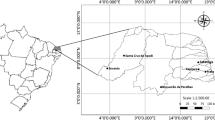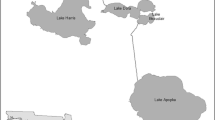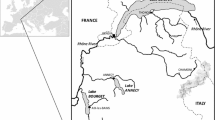Abstract
Past heat waves are considered harbingers of future climate change. In this study, we have evaluated the effects of two recent Central European summer heat waves (2003 and 2006) on cyanobacterial blooms in a eutrophic, shallow lake. While a bloom of cyanobacteria developed in 2006, consistent with our expectations, cyanobacterial biomass surprisingly remained at a record-low during the entire summer of 2003. Critical thresholds of abiotic drivers extracted from the long-term (1993–2007) data set of the studied lake using classification tree analysis (CTA) proved suitable to explain these observations. We found that cyanobacterial blooms were especially favoured in 2006 because thermal stratification was critically intense (Schmidt stability >44 g cm cm−2) and long-lasting (>3 weeks). Our results also suggest that some cyanobacterial species (Anabaena sp.) benefitted directly from the stable water column, whereas other species (Planktothrix sp.) took advantage of stratification-induced internal nutrient loading. In 2003, conditions were less favourable for cyanobacteria due to a spell of lower temperatures and stronger winds in mid-summer; as a result, the identified thresholds of thermal stratification were hardly ever reached. Overall, our study shows that extracting critical thresholds of environmental drivers from long-term records is a promising avenue for predicting ecosystem responses to future climate warming. Specifically, our results emphasize that not average temperature increase but changes in short-term meteorological variability will determine whether cyanobacteria will bloom more often in a warmer world.





Similar content being viewed by others
References
Berger C, Sweers HE (1988) The Ijsselmeer and its phytoplankton—with special attention to the suitability of the lake as a habitat for Oscillatoria agardhii Gom. J Plankton Res 10:579–599
Bormans M, Sherman BS, Webster IT (1999) Is buoyancy regulation in cyanobacteria an adaptation to exploit separation of light and nutrients? Mar Freshw Res 50:897–906
Breiman L, Friedman J, Stone CJ, Olshen RA (1993) Classification and regression trees. Chapman and Hall, Boca Raton
Butterwick C, Heaney SI, Talling JF (2005) Diversity in the influence of temperature on the growth rates of freshwater algae, and its ecological relevance. Freshw Biol 50:91–300
Ciais P, Reichstein M, Viovy N, Granier A, Ogeé J, Allard V, Aubinet M, Buchmann N, Bernhofer C, Carrara A et al (2005) Europe-wide reduction in primary productivity caused by the heat and drought in 2003. Nature 437:529–533
Daufresne M, Bady P, Fruget JF (2007) Impacts of global changes and extreme hydroclimatic events on macroinvertebrate community structures in the French Rhone River. Oecologia 151:544–559
De Nobel WT, Matthijs HCP, Von Elert E, Mur LR (1998) Comparison of the light-limited growth of the nitrogen-fixing cyanobacteria Anabaena and Aphanizomenon. New Phytol 138:579–587
De Senerpont Domis LN, Mooij WM, Huisman J (2007) Climate-induced shifts in an experimental phytoplankton community: a mechanistic approach. Hydrobiologia 584:403–413
De’Ath G, Fabricius KE (2000) Classification and regression trees: a powerful yet simple technique for ecological data analysis. Ecology 81:3178–3192
Dokulil MT, Teubner K (2000) Cyanobacterial dominance in lakes. Hydrobiologia 438:1–12
Downing JA, Watson SB, McCauley E (2001) Predicting cyanobacteria dominance in lakes. Can J Fish Aquat Sci 58:1905–1908
Driescher E, Behrendt H, Schellenberger G, Stellmacher R (1993) Lake Müggelsee and its environment—natural conditions and anthropogenic impacts. Int Rev Gesamten Hydrobiol 78:327–343
Elliott JA (2010) The seasonal sensitivity of cyanobacteria and other phytoplankton to changes in flushing rate and water temperature. Glob Change Biol 16:864–876
Fujimoto N, Sudo R, Sugiura N, Inamori Y (1997) Nutrient-limited growth of Microcystis aeruginosa and Phormidium tenue and competition under various N:P supply ratios and temperatures. Limnol Oceanogr 42:250–256
Huber V, Adrian R, Gerten D (2008) Phytoplankton response to climate warming modified by trophic state. Limnol Oceanogr 53:1–13
Huisman J, Hulot FD (2005) Population dynamics of harmful cyanobacteria. In: Huisman J, Matthijs PM, Visser PM (eds) Harmful cyanobacteria. Springer SBM, Heidelberg, pp 143–176
Huisman J, Sharples J, Stroom JM, Visser PM, Kardinaal WEA, Verspagen JMH, Sommeijer B (2004) Changes in turbulent mixing shift competition for light between phytoplankton species. Ecology 85:2960–2970
Huisman J, Matthijs PM, Visser PM (eds) (2005) Harmful cyanobacteria. Springer SBM, Heidelberg
Hyenstrand P, Blomquist P, Pettersson A (1998) Factors determining cyanobacterial success in aquatic systems—a literature review. Arch Fuer Hydrobiol Spec Issues Adv Limnol 51:41–62
Ibelings BW, Mur LR, Walsby AE (1991) Diurnal changes in buoyancy and vertical-distribution in populations of Microcystis in two shallow lakes. J Plankton Res 13:419–436
Jankowski T, Livingstone DM, Buhrer H, Forster R, Niederhauser P (2006) Consequences of the 2003 European heat wave for lake temperature profiles, thermal stability, and hypolimnetic oxygen depletion: implications for a warmer world. Limnol Oceanogr 51:815–819
Jöhnk KD, Huisman J, Sharples J, Sommeijer B, Visser PM, Stroom JM (2008) Summer heatwaves promote blooms of harmful cyanobacteria. Glob Change Biol 14:495–512
Köhler J, Hilt S, Adrian R, Nicklisch A, Kozerski HP, Walz N (2005) Long-term response of a shallow, moderately flushed lake to reduced external phosphorus and nitrogen loading. Freshw Biol 50:1639–1650
Kozerski HP, Behrendt H, Köhler J (1999) The N and P budget of the shallow, flushed lake Müggelsee: retention, external and internal load. Hydrobiologia 408:159–166
Meehl GA, Tebaldi C (2004) More intense, more frequent, and longer lasting heat waves in the 21st century. Science 305:994–997
Paerl HW (1988) Growth and reproductive strategies of freshwater blue-green algae (Cyanobacteria). In: Sandgreen CD (ed) Growth and reproductive strategies of freshwater phytoplankton. Cambridge University Press, Cambridge
Paerl HW, Huisman J (2008) Blooms like it hot. Science 320:57–58
Schär C, Jendritzky G (2004) Climate change: hot news from summer 2003. Nature 432:559–560
Schär C, Vidale P, Luthi D, Frei C, Haberli C, Liniger M, Appenzeller C (2004) The role of increasing temperature variability in European summer heatwaves. Nature 427:332–336
Scheffer M, Rinaldi S, Gragnani A, Mur LR, van Nes EH (1997) On the dominance of filamentous cyanobacteria in shallow, turbid lakes. Ecology 78:272–282
Smith VH (1983) Low nitrogen to phosphorus ratios favor dominance by blue-green algae in lake phytoplankton. Science 221:669–671
Smith VH, Schindler DW (2009) Eutrophication science: where do we go from here? Trends Ecol Evol 24:201–207
Soranno PA (1997) Factors affecting the timing of surface scums and epilimnetic blooms of blue-green algae in a eutrophic lake. Can J Fish Aquat Sci 54:1965–1975
Struzewska J, Kaminski JW (2008) Formation and transport of photooxidants over Europe during the July 2006 heat wave—observations and GEM-AQ model simulations. Atmospheric Chem Phys 8:721–736
Wagner C, Adrian R (2009) Cyanobacteria dominance: quantifying the effect of climate change. Limnol Oceanogr 54:2460–2468
Wilhelm S, Adrian R (2007) Long-term response of Dreissena polymorpha larvae to physical and biological forcing in a shallow lake. Oecologia 151:104–114
Wilhelm S, Adrian R (2008) Impact of summer warming on the thermal characteristics of a polymictic lake and consequences for oxygen, nutrients and phytoplankton. Freshw Biol 53:226–237
Wilhelm S, Hintze T, Livingstone DM, Adrian R (2006) Long-term response of daily epilimnetic temperature extrema to climate forcing. Can J Fish Aquat Sci 63:2467–2477
Acknowledgments
We thank all IGB scientists and technicians who have been involved in the collection and compilation of the long-term data set of Müggelsee. We are especially grateful to Thomas Hintze and Helgard Täuscher who helped during the preparation of the raw data. The German Research Foundation (DFG) supported Veronika Huber and Carola Wagner within the priority program AQUASHIFT (AD91/12-1; SPP 1162), and Rita Adrian and Dieter Gerten within the LakeRisk Project (AD91/13-1).
Author information
Authors and Affiliations
Corresponding author
Additional information
Communicated by Ulrich Sommer.
Electronic supplementary material
Below is the link to the electronic supplementary material.
Rights and permissions
About this article
Cite this article
Huber, V., Wagner, C., Gerten, D. et al. To bloom or not to bloom: contrasting responses of cyanobacteria to recent heat waves explained by critical thresholds of abiotic drivers. Oecologia 169, 245–256 (2012). https://doi.org/10.1007/s00442-011-2186-7
Received:
Accepted:
Published:
Issue Date:
DOI: https://doi.org/10.1007/s00442-011-2186-7




